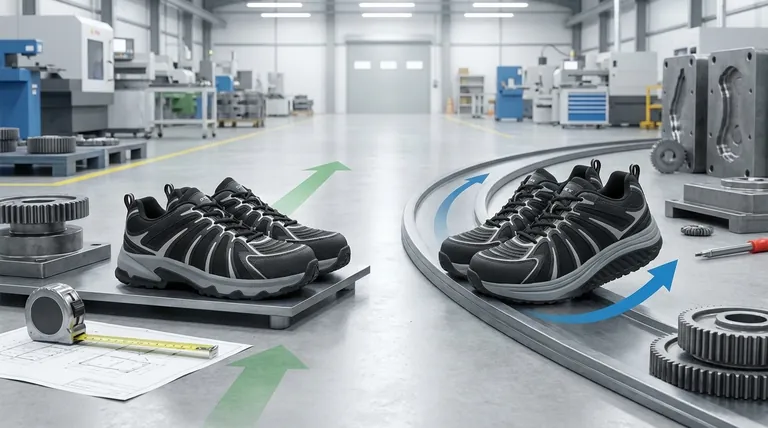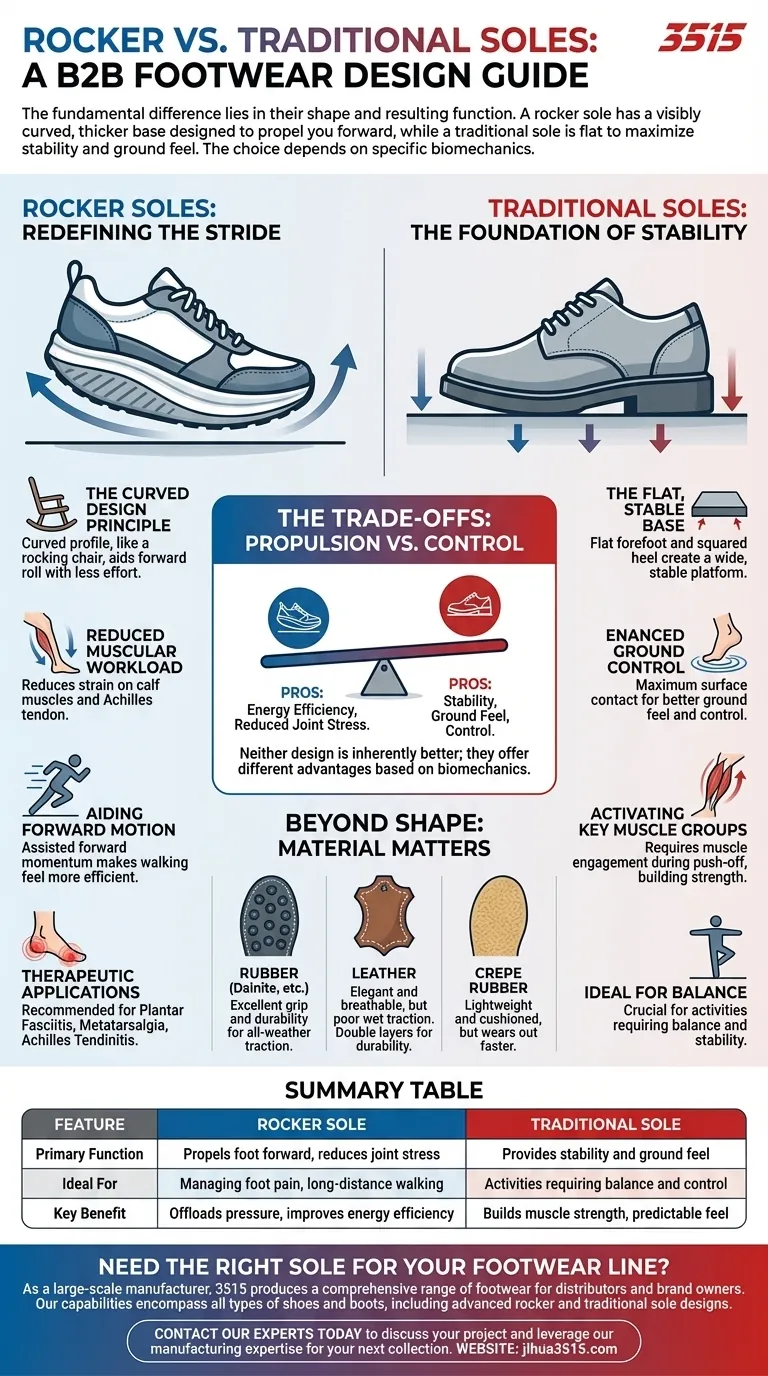The fundamental difference lies in their shape and resulting function. A rocker sole has a visibly curved, thicker base designed to propel you forward, while a traditional sole is flat to maximize stability and ground feel. Rocker soles essentially "roll" your foot through a step, whereas traditional soles require your foot and lower leg muscles to do more of the work.
The choice between a rocker and a traditional sole is not about which is superior, but which design best serves your specific biomechanics. Rocker soles offload stress from key joints and tendons, while traditional soles offer superior control and sensory feedback from the ground.

How Rocker Soles Redefine Your Stride
The core concept of a rocker sole is to create a smoother transition from heel-strike to toe-off, altering the natural mechanics of your gait.
The Curved Design Principle
A rocker sole is intentionally designed with a curved profile, similar to the bottom of a rocking chair. This shape helps your foot roll forward with less effort.
Reduced Muscular Workload
This rolling motion significantly reduces the workload on your calf muscles and the strain on your Achilles tendon. The shoe does some of the propulsive work for you.
Aiding Forward Motion
The primary benefit is assisted forward momentum. This can make walking feel more efficient and less fatiguing, especially over longer distances.
Therapeutic Applications
Because they offload pressure, rocker soles are often recommended for individuals managing conditions like plantar fasciitis, metatarsalgia (forefoot pain), or Achilles tendinitis.
The Foundation of Traditional Soles
Traditional soles are the classic, time-tested design that prioritizes a direct connection between your foot and the ground.
The Flat, Stable Base
Featuring a flat forefoot and often a squared heel, this design creates a wide, stable platform for your foot. This provides a consistent and predictable feel with every step.
Enhanced Ground Control
The flat profile allows for maximum surface contact, giving you better ground feel and control. This can be crucial for activities requiring balance or on uneven terrain.
Activating Key Muscle Groups
Unlike rocker soles, traditional designs require your calf and foot muscles to engage more fully during the push-off phase of your stride. This builds strength but can also cause fatigue.
Understanding the Trade-offs: Propulsion vs. Control
Neither design is inherently better; they simply offer different advantages and disadvantages based on their mechanical approach.
Stability and Ground Feel
A traditional sole is the clear winner for stability. Its flat, consistent surface provides unambiguous feedback from the ground. Some wearers find rocker soles can feel slightly unstable, especially when standing still.
Energy Efficiency and Joint Stress
A rocker sole excels at improving energy efficiency and reducing stress on specific joints, particularly the ankle and the ball of the foot. The trade-off is a less natural ground feel and reduced muscle engagement.
Beyond Shape: Why Sole Material Also Matters
The design of the sole is only half the story. The material it's made from has a massive impact on grip, durability, and comfort.
Rubber for All-Weather Traction
Materials like standard rubber or specialized Dainite rubber (with its studded design) offer excellent grip and durability, especially in wet or inclement weather.
Leather for Breathability and Formality
Leather soles are elegant and breathable but are known for having poor traction in wet conditions. A double leather sole can add durability for harsher environments.
Crepe for Lightweight Comfort
Crepe rubber is a lightweight and cushioned material, but it tends to wear out much faster than other rubber compounds.
Making the Right Choice for Your Footwear
Your ideal sole depends entirely on your personal needs and priorities.
- If your primary focus is managing foot pain (like plantar fasciitis or Achilles issues): A rocker sole is specifically designed to offload stress from these sensitive areas.
- If your primary focus is maximum stability and ground control: A traditional flat sole provides a more direct and predictable connection to the walking surface.
- If your primary focus is effortless forward momentum during long walks: The propelling design of a rocker sole can help reduce fatigue and make your stride feel more efficient.
Understanding your sole's design is the first step toward choosing footwear that works with your body, not against it.
Summary Table:
| Feature | Rocker Sole | Traditional Sole |
|---|---|---|
| Primary Function | Propels foot forward, reduces joint stress | Provides stability and ground feel |
| Ideal For | Managing foot pain, long-distance walking | Activities requiring balance and control |
| Key Benefit | Offloads pressure, improves energy efficiency | Builds muscle strength, predictable feel |
Need the right sole for your footwear line? As a large-scale manufacturer, 3515 produces a comprehensive range of footwear for distributors, brand owners, and bulk clients. Our production capabilities encompass all types of shoes and boots, including advanced rocker and traditional sole designs tailored to your market's needs. Contact our experts today to discuss your project and leverage our manufacturing expertise for your next collection.
Visual Guide

Related Products
- Premium KPU Athletic Safety Shoes for Wholesale
- Durable Rubber-Soled Utility Shoes for Wholesale & Custom Brand Manufacturing
- Premium Lightweight Safety Shoes for Wholesale & Bulk Orders
- Custom Safety Shoe Manufacturer for Wholesale & OEM Brands
- Wholesale Durable & Breathable Training Shoes for Custom Brands
People Also Ask
- Why is expert help recommended when selecting safety shoes? Ensure Perfect Fit & Hazard Protection
- What do the markings on ASTM-compliant safety shoes indicate? Decode the Safety Labels for Maximum Protection
- What materials are used in the construction of these boots? A Guide to Velour Leather, Textile & PU Soles
- What does a green triangle symbol on safety footwear mean? Your Guide to Maximum Puncture & Impact Protection
- What types of workplace hazards require protective footwear? Essential Guide for Workplace Safety



















